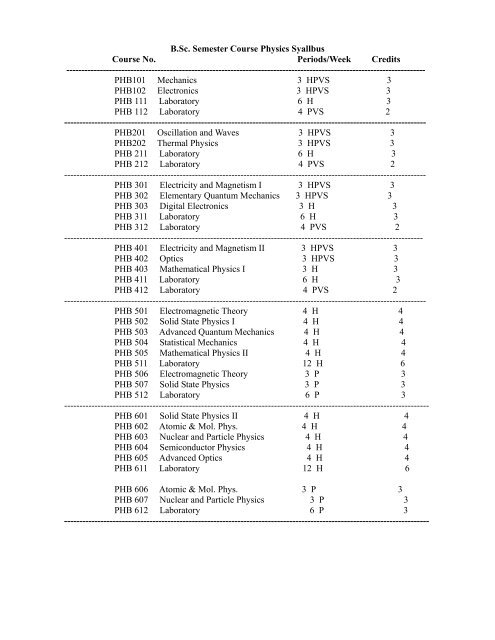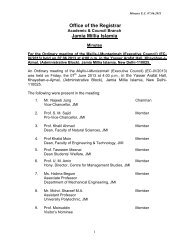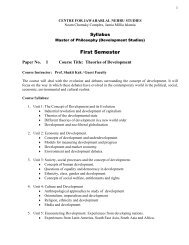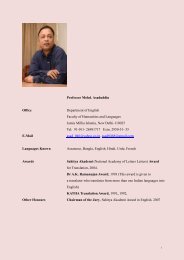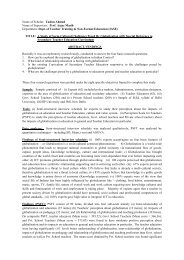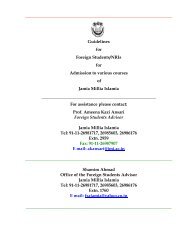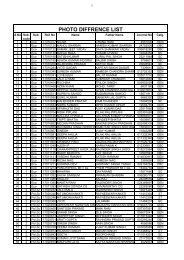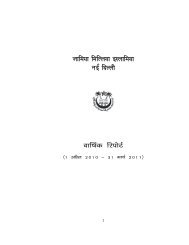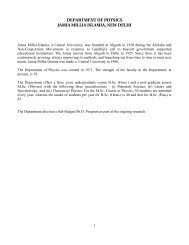B.Sc. Semester Course Physics Syallbus Course No. Periods/Week ...
B.Sc. Semester Course Physics Syallbus Course No. Periods/Week ...
B.Sc. Semester Course Physics Syallbus Course No. Periods/Week ...
You also want an ePaper? Increase the reach of your titles
YUMPU automatically turns print PDFs into web optimized ePapers that Google loves.
B.<strong>Sc</strong>. <strong>Semester</strong> <strong>Course</strong> <strong>Physics</strong> <strong>Syallbus</strong><br />
<strong>Course</strong> <strong>No</strong>. <strong>Periods</strong>/<strong>Week</strong> Credits<br />
----------------------------------------------------------------------------------------------------------------------<br />
PHB101 Mechanics 3 HPVS 3<br />
PHB102 Electronics 3 HPVS 3<br />
PHB 111 Laboratory 6 H 3<br />
PHB 112 Laboratory 4 PVS 2<br />
-----------------------------------------------------------------------------------------------------------------------<br />
PHB201 Oscillation and Waves 3 HPVS 3<br />
PHB202 Thermal <strong>Physics</strong> 3 HPVS 3<br />
PHB 211 Laboratory 6 H 3<br />
PHB 212 Laboratory 4 PVS 2<br />
-----------------------------------------------------------------------------------------------------------------------<br />
PHB 301 Electricity and Magnetism I 3 HPVS 3<br />
PHB 302 Elementary Quantum Mechanics 3 HPVS 3<br />
PHB 303 Digital Electronics 3 H 3<br />
PHB 311 Laboratory 6 H 3<br />
PHB 312 Laboratory 4 PVS 2<br />
----------------------------------------------------------------------------------------------------------------------<br />
PHB 401 Electricity and Magnetism II 3 HPVS 3<br />
PHB 402 Optics 3 HPVS 3<br />
PHB 403 Mathematical <strong>Physics</strong> I 3 H 3<br />
PHB 411 Laboratory 6 H 3<br />
PHB 412 Laboratory 4 PVS 2<br />
-----------------------------------------------------------------------------------------------------------------------<br />
PHB 501 Electromagnetic Theory 4 H 4<br />
PHB 502 Solid State <strong>Physics</strong> I 4 H 4<br />
PHB 503 Advanced Quantum Mechanics 4 H 4<br />
PHB 504 Statistical Mechanics 4 H 4<br />
PHB 505 Mathematical <strong>Physics</strong> II 4 H 4<br />
PHB 511 Laboratory 12 H 6<br />
PHB 506 Electromagnetic Theory 3 P 3<br />
PHB 507 Solid State <strong>Physics</strong> 3 P 3<br />
PHB 512 Laboratory 6 P 3<br />
------------------------------------------------------------------------------------------------------------------------<br />
PHB 601 Solid State <strong>Physics</strong> II 4 H 4<br />
PHB 602 Atomic & Mol. Phys. 4 H 4<br />
PHB 603 Nuclear and Particle <strong>Physics</strong> 4 H 4<br />
PHB 604 Semiconductor <strong>Physics</strong> 4 H 4<br />
PHB 605 Advanced Optics 4 H 4<br />
PHB 611 Laboratory 12 H 6<br />
PHB 606 Atomic & Mol. Phys. 3 P 3<br />
PHB 607 Nuclear and Particle <strong>Physics</strong> 3 P 3<br />
PHB 612 Laboratory 6 P 3<br />
------------------------------------------------------------------------------------------------------------------------
PHB101 Mechanics 3 Period/week HPVCS<br />
Unit I: Fundamentals of Dynamics<br />
- Newton's Laws of motion, dynamics of a system of particles, centre of mass, conservation of<br />
momentum impulse, momentum of variable mass system: motion of rocket<br />
- work-energy theorem, potential energy and energy diagrams, stable and unstable equilibrium<br />
- conservative and non-conservative forces, force as gradient of potential energy<br />
-particle collisions in centre of mass frame and laboratory frame<br />
-inertial frames and Galilean transformations, non-inertial frames and fictitious forces, uniformly<br />
accelerated system<br />
Unit II: Rotational Dynamics<br />
- angular momentum of a particle and a system of particles, torque and conservation of angular<br />
momentum, rigid body rotation about a fixed axis, moment of inertia: its calculation for regular<br />
bodies<br />
-moment of inertia tensor, kinetic energy of rotation, motion involving both translation and rotation<br />
-physics in rotating coordinate systems, centrifugal and coriolis forces<br />
Unit III: Gravitation and Central Force Motion<br />
- law of gravitation, inertial and gravitational mass, potential energy due to spherical shell and solid<br />
sphere, angular momentum conservation<br />
- one body problem, two body problem and its reduction to one body problem and its solution<br />
- the energy equation and energy diagram, Kepler’s laws, Satellites<br />
Unit IV: Special Theory of Relativity<br />
- Michelson-Morley experiment and its outcome<br />
- postulates of special theory of relativity, Lorentz transformations<br />
- simultaneity and order of events, Lorentz contraction and time dilation<br />
- velocity dependence of mass, equivalence of mass and energy<br />
REFERENCES :<br />
1. Kleppner & Kolenkow.<br />
2. Additional texts:<br />
3. Feynman Lectures-Volume I,<br />
4. Irodov-Problems in <strong>Physics</strong>,<br />
5. Resnick-Special Theory of Relativity,<br />
6. A.P. French-Newtonian Mechanics,<br />
7. Berkeley <strong>Physics</strong> <strong>Course</strong>-Mechanics
PHB102 Electronics 3 Period/week HPVCS<br />
Circuit Analysis: - Kirchhoff’s Laws, Mesh and <strong>No</strong>de Analysis of dc and ac Circuits, Duality in<br />
Networks, Equivalent Star (T) and delta (π) Networks. Star to Delta and Delta to Star Conversion.<br />
Network, Superposition theorem, Thevenins Theorem, <strong>No</strong>rton’s theorem. Wheatstone Bridge and<br />
its Applications to Wein Bridge and Anderson Bridge.<br />
Introduction to Semiconductor Diodes: – P and N Type Semiconductors. Energy Level Diagram.<br />
PN junction Diodes and its characteristics. Static and Dynamic Resistance. PN junction Rectifier<br />
Diode. Half-wave Rectifiers. Full-wave Rectifiers, Ripple Factor and Efficiency. Qualitative idea<br />
of C, L and π - Filters. Zener Diode and Voltage Regulation, Power supply. Basic concepts of Photo<br />
Diode, LED, and Varactor Diode.<br />
Bipolar Junction transistors: - N-P-N and P-N-P Transistors, Characteristics of CB, CE and CC<br />
Configurations. Active, Cutoff, and Saturation Regions, Transistor as a switch, Current gains α, β<br />
and γ and Relations. Load Line Analysis of Transistors. DC Load line and Q-point. Transistor in<br />
Active Region and it's Equivalent Circuit.<br />
Amplifiers:- Transistor Biasing and Stabilization. Transistor as 2-port Network. Amplifier and their<br />
classification, Class A, B, and C Amplifiers. Ideal amplifier- Voltage gain, current gain, Power gain,<br />
Input resistance, output resistance, load line.<br />
Oscillators:- Principle, Classification of Oscillators. Barkhauson’s Criterion for Self-sustained<br />
Oscillations. Essentials of Oscillators, RC Phase Shift Oscillator, Determination of Frequency.<br />
Wein-Bridge oscillator, Hartley Oscillator.<br />
REFERENCES :<br />
1. A. P. Malvino, Electronic Principals, Glencoe, 1993.<br />
2. Robert Boylestad, Louis Nashelsky, Electronic Devices and Circuit Theory, 8Th<br />
Edition, Pearson Education, India, 2004.<br />
3. John D. Ryder, Fundamentals of electronics<br />
4. D C Tayal, Basic Electronics<br />
5. Millman & Halkias, Electronic Device and circuits<br />
6. John Morris, Analog Electronics.<br />
7. Solid state electronic devices By Ben G. Streetman & Sanjay Banerjee, Pearson<br />
Prentice Hall, 2006.<br />
8. Basic Electronics & Linear Circuits By N. N. Bhargava, D. C. Kulshreshtha & SC<br />
Gupta, Tata McGrawHill, 2006<br />
9. Allen Mottershead, Electronic Circuits and Devices, PHI, 1997.
List of Experiments<br />
General :<br />
PHB111 Lab I (I <strong>Semester</strong>) 6 <strong>Periods</strong>/week H<br />
1. Least Count of Measuring Instruments (Vernier Callipers, <strong>Sc</strong>rew guage, Spherometer,<br />
Travelling Microscope, Stop watch, Ammeter, Voltmeter etc.<br />
2. Measurement of Length, Diameter and Radius of Curvature.<br />
3. Error analysis and Graph Drawing.<br />
Mechanics :<br />
4. Moment of Inertia of a Fly Wheel.<br />
5. Determination of "g" and radius of gyration by Bar Pendulum.<br />
6. Elastic constants by Searl's method.<br />
7. "Y" by bending of beam using optical lever method.<br />
8. Moment of Inertia of regular and irregular bodies by Torsion Table.<br />
9. Viscosity of water by Capillary flow method.
List of Experiments<br />
General :<br />
PHB112 Lab I (I <strong>Semester</strong>) 4 <strong>Periods</strong>/week PVS<br />
1. Least Count of Measuring Instruments (Vernier Callipers, <strong>Sc</strong>rew guage, Spherometer,<br />
Travelling Microscope, Stop watch, Ammeter, Voltmeter etc.<br />
2. Measurement of Length, Diameter and Radius of Curvature.<br />
3. Error analysis and Graph Drawing.<br />
Mechanics :<br />
4. Moment of Inertia of a Fly Wheel.<br />
5. Determination of "g" and radius of gyration by Bar Pendulum.<br />
6. Elastic constants by Searl's method.<br />
7. "Y" by bending of beam using optical lever method.<br />
8. Moment of Inertia of regular and irregular bodies by Torsion Table.<br />
9. Viscosity of water by Capillary flow method.
PHB201 Oscillation and Waves 3 Period/week HPVCS<br />
Unit 1: SHM :- Simple Harmonic Oscillations. Differential Equation of SHM and its Solution.<br />
Amplitude, Frequency, Time Period and Phase. Velocity and Acceleration. Kinetic, Potential and<br />
Total Energy and their Time Average Values. Reference Circle. Rotating Vector.<br />
Representation of SHM- Free Oscillations of Systems with One Degree of Freedom :- (1) Mass-<br />
Spring system, (2) Simple Pendulum, (3) Torsional Pendulum, (4) Oscillations in a U-Tube, (5)<br />
Compound pendulum: Centres of Percussion and Oscillation, and (6) Bar Pendulum.<br />
Unit 2: Superposition of Two Collinear Harmonic Oscillations :- Linearity and Superposition<br />
Principle. (1) Oscillations having Equal Frequencies and (2) Oscillations having Different<br />
Frequencies (Beats). Superposition of N Collinear Harmonic Oscillations with (1) Equal Phase<br />
Differences and (2) Equal Frequency Differences. Superposition of Two Mutually Perpendicular<br />
Simple Harmonic Motions with Frequency Ratios 1:1 and 1:2 using Graphical and Analytical<br />
Methods. Lissajous Figures and their Uses. System with Two Degrees of Freedom : Coupled<br />
Oscillators.<br />
Unit 3: Free Oscillations, Damped Oscillations, Forced Oscillations : Transient and Steady States,<br />
Amplitude, Phase, Resonance, Sharpness of Resonance, Power Dissipation and Quality Factor.<br />
Uinit 4: Wave Motion :- Plane and Spherical Waves. Longitudinal and Transverse Waves. Plane<br />
Progressive (Travelling) Waves. Wave Equation. Pressure of a Longitudinal Wave. Energy<br />
Transport. Intensity of Wave.<br />
Unit 5: Velocity of Transverse Vibrations of Stretched Strings. Velocity of Longitudinal Waves in a<br />
Fluid in a Pipe. Newton’s Formula for Velocity of Sound. Laplace’s correction. Superposition of<br />
Two Harmonic Waves :- Standing (Stationary) Waves in a String : Fixed and Free Ends. Analytical<br />
Treatment. Phase and Group Velocities. Changes wrt Position and Time. Energy of Vibrating String.<br />
Transfer of Energy. <strong>No</strong>rmal Modes of Stretched Strings. Plucked and Struck Strings. Melde’s<br />
Experiment. Longitudinal Standing Waves and <strong>No</strong>rmal Modes. Open and Closed Pipes.<br />
Superposition of N Harmonic Waves.<br />
Suggested Books:<br />
1. Vibrations and Waves by A. P. French.(CBS Pub. & Dist., 1987)<br />
2. The <strong>Physics</strong> of Waves and Oscillations by N.K. Bajaj (Tata McGraw-Hill, 1988)<br />
3. Fundamentals of Waves & Oscillations By K. Uno Ingard (Cambridge University Press, 1988)<br />
4. An Introduction to Mechanics by Daniel Kleppner, Robert J. Kolenkow (McGraw-Hill, 1973)<br />
5. Waves: BERKELEY PHYSICS COURSE (SIE) by Franks Crawford (Tata McGrawHill,<br />
2007).
PHB202 Thermal <strong>Physics</strong> 3 Period/week HPVCS<br />
Unit 1: Kinetic theory of gases<br />
Derivation of Maxwell’s law of distribution of velocities and its experimental verification. Mean<br />
free path. Transport phenomena, viscosity.<br />
Unit 2: Ideal gases<br />
Equation of states, internal energy, specifics heat, entropy. Isothermal and adiabatic processes.<br />
Unit 3: Real gases<br />
Deviation from the ideal gases equation. Andrew’s experiments on carbon dioxide gas, continuity of<br />
liquid and gaseous states. Vaanderwaal’s equation . Critical constants and law of corresponding<br />
states. Joule –Thompson effect.<br />
Unit 4: Thermodynamics<br />
Zeroth and first law of thermodynamics. Reversible and irreversible processes. Conversion of heat<br />
into work. Carnot’s theorem. Second law of thermodynamics. Thermodynamics scale of temper-<br />
ature. Clausius inequality. Entropy changes in reversible and irreversible proceses. Temperature–<br />
Entropy diagram. The principle of increase of entropy.<br />
Unit 5: Thermodynamic Functions<br />
Maxwell’s relations and their applications. Change of phase. Equilibrium between a liquid and its<br />
vapour. Clausius–Claperyron equation. Triple point with examples from physics. Second order<br />
phase transitions.<br />
Unit 6: Radiation<br />
Kirchoff’s law. Black body radiation. Wein’s displacement law. Stefan–Boltzmann law. Plank’s<br />
law of radiation and qualitative introduction to quanta of radiation.<br />
References :<br />
1. A Text book of heat: M. N Saha and B.N Srivastava (<strong>Sc</strong>ience book Agency Publications)<br />
2. Heat and Thermodynamics: An Intermediate Textbook By<br />
Mark Waldo Zemansky, Richard Dittman (McGraw-Hill, 1981).<br />
3. Thermal <strong>Physics</strong> : Garg, Bansal and Ghosh (Tata McGraw-Hill, 1993).<br />
4. Thermodynamics, Kinetic Theory, and Statistical Thermodynamics:<br />
Francis W. Sears & Gerhard L. Salinger.( Narosa, 1986).
Basic Electronics:<br />
PHB 211 Lab II (<strong>Semester</strong> II) 6 periods/week H<br />
1. Growth and Decay of charge on a condenser in RC circuit.<br />
2. I-V characteristic of P-N junction and Zener diode.<br />
3. Input and output characteristics of transistors (CE).<br />
4. Half wave and Full wave rectifier and ripple factor.<br />
5. Variation of frequency of an Oscillator.<br />
Thermal <strong>Physics</strong>:<br />
6. Thermal Conductivity of a good conductor by Searl's method.<br />
7. Determination of Thermal conductivity of rubber tubing.<br />
8. Ratio of two specific heats of a gas by Clement and Desorme's method.<br />
9. Relation between energy radiated by a bulb and absolute temperature of the filament of the<br />
bulb.
Basic Electronics:<br />
PHB 212 Lab II (<strong>Semester</strong> II) 4 periods/week PVS<br />
1.Growth and Decay of charge on a condenser in RC circuit.<br />
2. I-V characteristic of P-N junction and Zener diode.<br />
3. Input and output characteristics of transistors (CE).<br />
4. Half wave and Full wave rectifier and ripple factor.<br />
5.Variation of frequency of an Oscillator.<br />
Thermal <strong>Physics</strong>:<br />
6. Thermal Conductivity of a good conductor by Searl's method.<br />
7. Determination of Thermal conductivity of rubber tubing.<br />
8. Ratio of two specific heats of a gas by Clement and Desorme's method.<br />
9. Relation between energy radiated by a bulb and absolute temperature of the filament of the bulb.
Unit 1<br />
PHB301 Electricity and Magnetism I 3 Period/week HPVCS<br />
The topics in this unit are to be revised by the students with minimal help from the teacher. These<br />
results will frequently be used in subsequent units.<br />
Mathematical Background: Functions of two and three variables, partial derivatives, geometrical<br />
interpretation of partial derivatives of functions of two variables. Total differential of a function of<br />
two and three variables, higher order derivatives, repeated integrals of a function of more than one<br />
variables, definition of double and triple integrals, change of variables of integrals, Jacobian.<br />
<strong>Sc</strong>alars and vectors, dot and cross products, triple vector product, gradient of a scalar field and its<br />
geometrical interpretation, divergence and curl of a vector field, line, surface and volume integrals,<br />
flux of a vector field, Gauss’s divergence theorem, Green’s theorem and Stokes theorem; curvilinear<br />
co-ordinates: spherical, polar, cylindrical.<br />
Unit 2<br />
Electrostatics: Coulomb’s law in vacuum expressed in vector forms, unit of charge(SI system),<br />
conservation and quantization of charge; calculation of E(r) for simple distributions of charges at<br />
rest: monopole, dipole, quadrupole fields. Work done on a charge in an electrostatic field expressed<br />
as a line integral, conservative nature of the electrostatic field, electric field as a gradient of scalar<br />
field Er‐ V, flux of the electric field, Gauss’s law and its applications for finding electric field<br />
for symmetric charge distributions, Gaussian pillbox, fields at the surface of a conductor, screening<br />
of electric field by a conductor, capacitors, electrostatic field energy, force per unit area on the<br />
surface of a conductor in an electric field, induced charges; point charge in front of a grounded<br />
infinite conductor, method of images. Field equations for electric field in vacuum, energy associated<br />
with electric field. Differential form of Gauss’s law, Poisson’s equation, Laplace’s equation,<br />
solution’s of Laplace’s equation in rectangular, spherical and cylindrical co-ordinates; boundary<br />
conditions, uniqueness theorem.<br />
Unit 3<br />
Magnetostatics: magnetic field B(r) seen through Lorentz force on a moving charge, unit for B<br />
defined through force on a straight current, magnetic field due to current: Biot-Savart’s law; Field<br />
equations in magnetostatics: .Br0, Ampere’s law, fields due to a straight wire and a circular<br />
current loop; magnetic dipole, circular current and solenoid.<br />
Unit 4<br />
Faraday’s law of electromagnetic induction: Integral and differential forms, motional emf, the<br />
induced electric field, Inductance : mutual and self, transformers, magnetic energy of coupled<br />
circuit’s energy in a static magnetic field.
REFERENCES :<br />
1. “Introduction to Electrodynamics” by D.J. Griffiths (Prentice Hall of India Private Limited)<br />
2. “Electricity and Magnetism” by A.S. Mahajan and A.A. Rangwala (Tata McGraw Hill)<br />
3. “Electricity and Magnetism” Berkeley <strong>Physics</strong> <strong>Course</strong> ed. E.M. Purcell<br />
4. “<strong>Physics</strong>”, Vol. 2 Halliday and Resnick
PHB302 Elementary Quantum Mechanics 3 Period/week HPVCS<br />
Unit 1:<br />
Review of History of Origin of Quantum Mechanics-Plank's Quantum<br />
Hypothesis, Photon<br />
Nature of Light, de Broglie Waves and Wave- Particle Duality,<br />
Heisenberg's Uncertainty<br />
Principle.<br />
Unit 2:<br />
Linear Operators. Eigen value problem. Eigen value of a Hermition and<br />
Unitary Operators.<br />
Expectation Values. Commutator bracket and Uncertainty relations.<br />
Unit 3:<br />
Postulates of quantum mechanics. <strong>Sc</strong>hrodinger wave equation. Born's<br />
interpretation of wave<br />
function.<br />
Unit 4:<br />
One dimensional potential well; Infinite square well potential and<br />
qualitative discussion of<br />
finite square well potential. Barrier penetration. Simple harmonic oscillator.<br />
Unit 5:<br />
Spherically symmetric potentials. Angular momentum operator. Eigen<br />
values of L and L.<br />
Communication Relations. Solution of Hydrogen atom Problem. Degeneracy<br />
of Energy levels.<br />
Suggested books :<br />
1. Beiser : Concepts in Modern <strong>Physics</strong><br />
2. Mani Mehta : Modern <strong>Physics</strong><br />
3. Bernstein, Fishbane & Gasiorowicz: Modern <strong>Physics</strong><br />
4. <strong>Sc</strong>hwabl : Quantum Mechanics<br />
5. Ghatak : Quantum Mechanics<br />
6. Gasiarowicz : Quantum <strong>Physics</strong><br />
7. Bransden and Joachain: Quantum Mechanics<br />
8. Thankappan: Quantum Mechanics
PHB303 Digital Electronics 3 Period/week H<br />
UNIT 1 :<br />
Binary, octal, hexadecimal and decimal Number systems. Interconversion among different number<br />
systems. Binary arithmatic. BCD and other types of codes. 1's and 2's compliment of a binary<br />
number. Positive and negative logic. AND, OR, NOT, NAND, XOR, NOR and XNOR Gates.<br />
Symbols and truth tables. NAND and NOR gates as universal gates.<br />
UNIT 2 :<br />
<strong>No</strong>ise in electrical circuits. Transmission of binary data as voltage pulses. Corruption of data<br />
because of noise. Error detection : Parity. Error correcting codes : Hamming distance, Hamming<br />
(7,4) codes. Hadamard code. Elementary introduction to coding theory.<br />
UNIT 3 :<br />
Introduction to different logic families, like RTL, DTL, HTL, IIL, TTL, ECL, CMOS, their merits<br />
and demerits. Basic concepts of fan in and fan out, sinking and sourcing of current. Case study of<br />
TTL family, voltage levels, TTL NAND gate, totem-pole and open collector output.<br />
UNIT 4 :<br />
Boolean algebra :- De Morgan’s Theorems. Boolean Laws. Simplification of Logic Circuit<br />
using Boolean Algebra. Fundamental Products. Minterms and Maxterms. Conversion of a<br />
Truth Table into an Equivalent Logic Circuit by (1) Sum of Products (SOP) method and (2) Product<br />
of sums (POS) method. Simplification of switching functions using Karough maps upto 4 variable.<br />
UNIT 5 : Different types of circuits<br />
Arithmetic Circuits :- Binary Addition. Binary Subtraction using 2’s Complement Method).<br />
Half Adders and Full Adders and Subtractors (only up to Eight Bits).<br />
Data processing circuits :- Basic Idea of Multiplexers, De-multiplexers, Decoders, Encoders,<br />
Parity Checkers.<br />
Sequential Circuits :- RS, D, and JK Flip-Flops. Level Clocked and Edge Triggered Flip-Flops.<br />
Preset and Clear Operations. Race-around Conditions in JK Flip-Flops. Master-Slave JK Flip-<br />
Flop (As Building Block of Sequential Circuits).1. Beiser : Concepts in Modern <strong>Physics</strong><br />
2. Mani Mehta : Modern <strong>Physics</strong><br />
3. Bernstein, Fishbane & Gasiorowicz: Modern <strong>Physics</strong><br />
4. <strong>Sc</strong>hwabl : Quantum Mechanics<br />
5. Ghatak : Quantum Mechanics<br />
6. Gasiarowicz : Quantum <strong>Physics</strong><br />
7. Bransden and Joachain: Quantum Mechanics<br />
Shift registers : - Serial-in-Serial-out, Serial-in-Parallel-out, Parallel-in-Serial-out, and<br />
Parallel-in-Parallel-out Shift Registers (only upto 4 bits).<br />
Counters : - Asynchronous and Synchronous Counters. Ring Counters. Decade Counter.<br />
D/A and A/D conversion : - D/A converter – Resistive network. Accuracy and Resolution.<br />
Suggested Books:<br />
1. Digital principles and applications By Donald P. Leach & Albert Paul Malvino,<br />
2. Digital Fundamentals, 3rd Edition by Thomas L. Floyd (Universal Book Stall, India,<br />
1998).<br />
3. Digital Electronics by R.P. Jain,<br />
4. Digital Electronics by V K Puri, TMH.
List of Experiments:<br />
Optics:<br />
PHB311 Lab III (<strong>Semester</strong> III) 6 <strong>Periods</strong>/week H<br />
1.Focal length of two lenses by <strong>No</strong>dal Slide method and verification of Newton's formula.<br />
2.Determination of Magnifying and Resolving power of a telescope.<br />
3. Refractive Index and Dispersive Power of a Prism using spectrometer.<br />
4. Wavelength of light using plane transmission diffraction grating.<br />
5. Resolving power of a grating.<br />
6. Wavelength of light by Newton's Rings method.<br />
7. Diffraction at straight edge.<br />
8. Specific Rotation of Sugar solution by Laurent's Half-Shade Polarimeter.<br />
9. Study of elliptically, polarized light rising Babinet's Compensator.<br />
10. Determination of particle size using Laser.
List of Experiments:<br />
Optics:<br />
PHB312 Lab III (<strong>Semester</strong> III) 4 <strong>Periods</strong>/week PVS<br />
1.Focal length of two lenses by <strong>No</strong>dal Slide method and verification of Newton's formula.<br />
2.Determination of Magnifying and Resolving power of a telescope.<br />
3.Refractive Index and Dispersive Power of a Prism using spectrometer.<br />
4. Wavelength of light using plane transmission diffraction grating.<br />
5.Resolving power of a grating.<br />
6. Wavelength of light by Newton's Rings method.<br />
7. Diffraction at straight edge.<br />
8. Specific Rotation of Sugar solution by Laurent's Half-Shade Polarimeter.<br />
9. Study of elliptically, polarized light rising Babinet's Compensator.<br />
10. Determination of particle size using Laser.
PHB401 Electricity and Magnetism II 3 Period/week HPVS<br />
Unit 1 : ELECTRICAL CURRENTS AND CIRCUITS<br />
Steady current, Current density J, non-steady currents and continuity equation, Varying currents:<br />
rise and decay of currents in LR and CR circuits, decay constants, AC circuit problems: complex<br />
impedance and reactance, phasor algebra, frequency response - series and parallel circuits,<br />
resonance, Q factor, Power dissipation and power factor<br />
Unit 2 : ELECTROSTATIC FIELDS IN MATTER<br />
Dielectrics - Polarization and Induced Dipoles, Bound charges. The field of a polarized object,<br />
Bound charges and their physical interpretations, Field inside a dielectric. The Gauss’s law in the<br />
presence of dielectrics. The Electric Displacement Vector D. Susceptibility, permittivity, dielectric<br />
constant. Energy in Dielectric systems, Forces on Dielectrics, Clausius-Mossotti equation, Polar<br />
molecules. The Langevin formula.<br />
Unit 3 : MAGNETIC FIELDS IN MATTER<br />
Magnetization - Diamagnetism, Paramagnetism, Ferromagnetism, The field of a magnetized object<br />
- Bound currents and their physical interpretation, The magnetic field inside matter. Ampere’s law<br />
in magnetized medium, the magnetic field intensity vector H, Magnetic Susceptibility and<br />
Permeability. Ferromagnetism - energy loss in Hysteresis and B-H curve.<br />
REFERENCES :<br />
1. “Introduction to Electrodynamics” by D.J. Griffiths (Prentice Hall of India Private Limited)<br />
2. “Electricity and Magnetism” by A.S. Mahajan and A.A. Rangwala (Tata McGraw Hill)<br />
3. “Electricity and Magnetism” Berkeley <strong>Physics</strong> <strong>Course</strong> ed. E.M. Purcell<br />
4. “<strong>Physics</strong>”, Vol. 2 Halliday and Resnick
1. Interference :<br />
PHB402 Optics 3 Period/week HPVCS<br />
Coherent sources, Yopung’s Double slit expreiment, Division of wave<br />
front. Fresnel’s biprism. Division of amplitude. Interference in thin<br />
films. Newton’s rings. Michelson’s interferometer.<br />
2. Diffraction :<br />
Fraunhofer diffraction at single, double and N slits. Fresnel diffraction<br />
at a straight edge and circular aperture. Cornu-spiral. Half-period<br />
zones. Zone plate. Diffraction grating.<br />
3. Polarization :<br />
Plane, circular and elliptical polarization of light. Double refraction.<br />
Nicol prisms. Wave plates. Optical activity.<br />
4. Micellaneous Topics :<br />
Huygens principle. Fermat’s principle. Resolving power of optical in-<br />
strunents and diffraction grating. Principle of lasers and holography.<br />
Suggested Books :<br />
1. A. K.Ghatak : Optics<br />
2. Jenkins and White : Fundamentals of Optics<br />
3. Max Born andf Emil Wolf : Principles of Optics
1. Review of Basics :<br />
PHB403 Mathematical <strong>Physics</strong> I 3 Period/week H<br />
Review of differential and integral calculus. Gaussian integral. Infinite<br />
series. Ordinary differential equations.<br />
2. Linear Algebra :<br />
Vector spaces. Linear independence. Basis. Dimension. Linear trans-<br />
formations. Matrices. Vector subspaces. Quotient space. Inner prod-<br />
uct.<br />
3. Vector Calculus :<br />
Dot and cross product of vectors. Definition of gradient, curl and diver-<br />
gence. Gauss and Stokes theorems. Introduction to partial differntial<br />
equations of physics.<br />
4. Curvilinear coordinates and Multiple integrals :<br />
Calculation of divergence, gradient etc. in spherical polar and cylin-<br />
drical coordinates. Multiple integrals in two and three dimensions.<br />
Change of variable and Jacobian. Area of surfaces and volume of solids.<br />
Suggested Books :<br />
1. Vector Analysis : <strong>Sc</strong>haum Series<br />
2. Advanced Engineering Mathematics bt Kreyzig<br />
3. Linear Algebra : <strong>Sc</strong>haum Series
PHB411 Lab IV (<strong>Semester</strong> IV) 6 <strong>Periods</strong>/week H<br />
Electricity and Magnetism:<br />
1. Determination o E.C.E. of copper using a Copper Voltameter and checking the accuracy of<br />
ammeter.<br />
2. Determination of Self Inductance of a coil using Anderson's Bridge.<br />
3. Determination of Plank's constant by cut off method.<br />
4. Study of LCR circuit-impedence determination.<br />
5. e/m by Tomson's method.<br />
6. Determination of Galvanometer resistance by Kelvin method and determine the sensitivity<br />
of the Galvanometer.<br />
7. Conversion of a moving coil galvanometer into an ammeter and voltmeter.<br />
8. Determination of mechanical equivalent of heat by electrical (static) method.<br />
9. Determination of self inductance of a coil by Rayleigh method.
PHB412 Lab IV (<strong>Semester</strong> IV) 4 <strong>Periods</strong>/week PVS<br />
Electricity and Magnetism:<br />
1.Determination o E.C.E. of copper using a Copper Voltameter and checking the accuracy of<br />
ammeter.<br />
2.Determination of Self Inductance of a coil using Anderson's Bridge.<br />
3.Determination of Plank's constant by cut off method.<br />
4. Study of LCR circuit-impedence determination.<br />
5. e/m by Tomson's method.<br />
6. Determination of Galvanometer resistance by Kelvin method and determine the sensitivity of the<br />
Galvanometer.<br />
7. Conversion of a moving coil galvanometer into an ammeter and voltmeter.<br />
8. Determination of mechanical equivalent of heat by electrical (static) method.<br />
9. Determination of self inductance of a coil by Rayleigh method.
PHB501 Electromagnetic Theory 4 <strong>Periods</strong>/week H<br />
Unit -1:Introduction<br />
Maxwell's Equations,Gaussian Unites, Macroscopic media, Boundary conditions at media interfaces,<br />
Gauge potentials,Coulom's law, Gauss's law, Electrostatic potential, Uniqueness theorem, Green's<br />
theorem, Green functions and the boundary value problems, Electrostatic energy.Some problems.<br />
Unit-2:Boundary value problems in electrostatics: 1<br />
Method of images, Point Charge in the presence of a grounded conducting sphere; point charge in the<br />
presence of a charged , insulated, conducting sphere; point charge near a conduting sphere at a fixed<br />
potentia; conducting sphere in a uniform electric field by image-method; Green function for the<br />
sphere:General solution for the potential; Conducting sphere with hemispheres at different potentials;<br />
Orthogonal Functions and expantions ; Separation of variables in Cartesian coordinates, Generalized<br />
Fouriar expantions. Some problems.<br />
Unit-3:Boundary value problems in electrostatics: 2<br />
Laplace equation in spherical coordinates, Series sulution of the Legendre Equation, Rodrigues formula,<br />
the generating function, Expantion in Legendre polynomials, boundary value problems with asymuthal<br />
symmetry, Associated Legendre function , spherical harmonics, general solution of Laplece's equation<br />
without azimuthal symmetry,addition theorem for spherical harmonics, Laplace equation in cylindrical<br />
coordinates, Bessel function ,boundary value problems in cylindrical coordines, Green function in<br />
cylindrical polar coordinates<br />
Unit-4: Multipole expantion and Dieletric media<br />
Multipole expantion , multipole expantion of a charge distribution in an external field, microscopic<br />
description of dielectric media, examples of dielectri media, boundary value problems with dielectrics,<br />
molecular polarizability and electric susceptibility, models for electric polarizability, electrostatic energ<br />
in dielectric media. Some problems .<br />
Unit-5:Magnetostatics<br />
Biot and Savart law, Differential equations of Magnetostatics and Amperes law, Vector potential , vector<br />
potencial and magnetic induction for a circular current loop. magnetic fields of a localized current<br />
distribution. Magnetic moment, force and torque on and energy of a localized current distribution in an<br />
external magnetic induction.macroscopic equations, boundary conditions at medium interfaces,<br />
techniques for solving boundary value problems in magnetostatics.<br />
Unit-6:Electomagnetic plane waves and wave propagation<br />
Plane waves in a nonconducting medium, linear and circular polarization, stokes parameters, reflection<br />
and refraction at a plane interface, Brewster’s angle, total internal reflection,<br />
Action principle for Maxwell’s equations.<br />
Oscillator model for frequency dependence of a dielectric, conductivity, group velocity, causality and<br />
dispersion relations, causal propagation.<br />
Unit-7:wave-guides and cavities<br />
The approximation of perfect conductions, Waveguides, rectangular waveguide, energy flow and<br />
attenuation, resonant cavities, perturbation of boundary conditions, excitation of waveguide modes.<br />
REFERENCES :<br />
1. IIntroduction to Electrodynamics” by D.J. Griffiths (Prentice Hall of India Private Limited)<br />
2. “Foundations of Electromagnetic Theory” by J.R. Reitz, F.J. Millford and R.W. Christry<br />
(Narosa Publishing House)<br />
3. “Introduction to Electromagnetic Field and Waves” by Corson and Lorrain
PHB502 Solid State <strong>Physics</strong> I 4 Period/week H<br />
Unit 1: Crystal Structure<br />
Crystalline state of solids, Lattice Translation Vector, Unit cell, Wigner- Seitz cell, Number of<br />
lattice point per unit cell, packing fraction, Bravais lattice, Miller indices, Interplaner spacing,<br />
Symmetry elements.<br />
Unit 2: X-rays and Atomic Bonding<br />
Continuous and characteristic X-rays spectra, Absorption of X-rays, Diffraction of X-rays, Bragg’s<br />
law, Laue’s equations, Powder method, Interatomic forces and classification of solids, Bond<br />
dissociation Energy, Cohesive Energy of ionic crystal, Types of Bonds; Ionic bond, Covalent bond,<br />
Metallic Bonding, Van der Waals Bonding.<br />
Unit 3: Elementary Lattice Dynamics<br />
Lattice Vibrations and Phonons: Linear Monoatomic and Diatomic molecules chains, Acoustical<br />
and Optical Phonons, Qualitative Description of the Phonon spectrum in solids, Einstein and Debye<br />
theories of specific heat of solids, Debye T3 law.<br />
Unit 4: Electrical Conductivity<br />
Free electron theory, Sommerfeld model, Fermi level, Density of states, Electrical conductivity of<br />
metals and its temperature dependence, Weidemann-Franz law, Hall Effect.<br />
Unit 5: Defects in Solids<br />
Point defects-Frenkel and <strong>Sc</strong>hottky vacancies, Line defects-Edge and screw dislocations, Planer<br />
defects, Stacking faults.<br />
REFERENCES:<br />
1. Charles Kittle : Introduction to Solid State <strong>Physics</strong>.<br />
2. Henry Lipson : Interpretation of X-ray Wooter Photographs<br />
3. Charles S Barrett : Structure of Metals<br />
4. Azaroff L. V : Introduction to Solids<br />
5. Cochran W : The Dynamics of Atoms in Crystals<br />
6. Wahab.M.A. : Solid State <strong>Physics</strong> ( Structure and Properties of Materials )
Unit 1 :<br />
PHB503 Advanced Quantum Mechanics 4 Period/week H<br />
Wave functions and wave packets in position and momentum space and their relation using Fourier<br />
transform. Time evolution of Gaussian wave packets. Localized states and theUncertainty Principle.<br />
Inner product and <strong>Sc</strong>hwarz inequality. Position-momemtum uncertainty relation.<br />
Energy level width and decay time relation.<br />
<strong>Sc</strong>hrodinger equation for a single particle. Hermiticity of operator. Ehrenfest theorem. Commutator<br />
relations. Probability current and continuity equation. Eigenfunctions and eigenvalues of a<br />
Hermitian operator. Orthogonality and completeness. Stationary states.<br />
Unit 2:<br />
Harmonic oscillator. Ladder operators and number operator. Hermite Polynomials. Coherent states.<br />
Tunneling through step and continuous barriers and application to alpha-decay. Potential well:<br />
symmetries of ground state, Parity, resonances.<br />
Unit 3:<br />
Angular momentum. L Operator as a generator of rotations, commutation relations, eigenfunctions,<br />
eigenvalues, L in polar co-ordinates, Legendre equation, Spherical harmonics. Central Potentials<br />
and bound state problems in 3 dimensions. Laguerre polynomials. Degeneracies of eigenvalues.<br />
Motion in E-M field and Zeeman effect.<br />
Unit 4:<br />
Operators and matrices, state vectors, unitary transformations, <strong>Sc</strong>hrodinger and Heisenberg<br />
representations.<br />
Unit 5:<br />
Spin angular momentum. Stern-Gerlach Experiment. Addition of angular momenta.<br />
Suggested books :<br />
1. Beiser : Concepts in Modern <strong>Physics</strong><br />
2. Mani Mehta : Modern <strong>Physics</strong><br />
3. Bernstein, Fishbane & Gasiorowicz: Modern <strong>Physics</strong><br />
4. <strong>Sc</strong>hwabl : Quantum Mechanics<br />
5. Ghatak : Quantum Mechanics<br />
6. Gasiarowicz : Quantum <strong>Physics</strong><br />
7. Bransden and Joachain: Quantum Mechanics<br />
8. Thankappan: Quantum Mechanics
UNIT 1:<br />
PHB504 Statistical Mechanics 4 Period/week H<br />
Review of thermodynamic laws; Thermodynamic potentials: Legendre transfor-<br />
mation; the Entropy Maximum Postulates; the Energy Minimum Principle;<br />
Macrostates and Microstates; Phase-Space representation; Liouville’s theorem; Boltz-<br />
man Entropy relation; Statitical interpretation of second law of thermodynamics; classical<br />
ideal gas; Gibb’s paradox;<br />
UNIT 2:<br />
Statistical Mechanics in the Entropy representation: The Microcanonical En-<br />
semble; principle of equal a priori probabilities; Harmonic oscillator; the Einstein model<br />
ofi crystalline solid; The two-level system: Negative temperature;<br />
UNIT 3:<br />
Statistical Mechanics in Helmholtz representation: The Canonical Ensemble;<br />
probability distribution; additive energies and factorizability of the partition function;<br />
Equipartition theorem; internal modes in a gas; The Debye model of nonmetallic crystals;<br />
Electromagnetic Radiation;<br />
UNIT 4:<br />
Grand Canonical Ensemble and Quantum Statistics: The ideal Fermi gas; the<br />
classical limit and quantum criteria; the strong quantum regime: electrons in a metal; the<br />
ideal Bose gas; non-conserved ideal Bose gas: Photons; Bose-Einstein Condensation.<br />
REFERENCES :<br />
1. F. Reif : Fundamentals of Statistical and Thermal <strong>Physics</strong>.<br />
2. H. B. Callen: Thermodynamics and an Introduction to Thermostatistics, John Wiley<br />
and Sons.<br />
3. Greiner, Neiser and Stocker: Thermodynamics and Statistical Mechanics; Springer.
PHB505 Mathematical <strong>Physics</strong> II 4 Period/week H<br />
Complex Analysis ( 8 lectures )<br />
Review of complex arithmetic; Complex differentiation: Analyticity of complex functions, Cauchy<br />
Reimann conditions; Complex integration: Cauchy integral theorem, Cauchy integral formula,<br />
derivative as integral; Complex series: Taylor and Laurent series;<br />
Calculus of Residues: Residues and its application to some useful integrals (of physics).<br />
Dirac Delta Function, Fourier Series and Transform<br />
Dirac delta function: linear density of points; properties and useful representations in one, two and<br />
three dimensions; integral representation of the delta function;<br />
Fourier series and transform: Expansions of functions of arbitrary periods; even and odd functions,<br />
half range expansions; complex form; Fourier Transform.<br />
Differential Equations and Special Functions<br />
PDE's to ODE's: Separation of variables in Cartesian, Cylinderical and Spherical Coordinates;<br />
First order differential equations: <strong>No</strong>rmal form of FODE, Integrating factors, first order linear<br />
differential equations;<br />
Second order linear differential equations : Linearity, Superposition, Uniqueness, Wronskian; the<br />
general solutions of<br />
the homogeneaous and inhomogeneaous cases;<br />
Second order linear differential equation with constant coefficient, central force problem;<br />
Laplace's equation in Cartesian coordinates;<br />
Laplace's equation in spherical coordinates: Legendre's differential equation; series solution,<br />
orthogonality, recurrence and orthogonality relations; expansions in Legendre polynomials;<br />
Laplace's equation in cylinderical coordinates: solutions of Bessel's differential equation; generating<br />
functions, recurrence relations etc; expansions in Bessel's functions and examples;<br />
Some other PDE's of physics: Heat, wave and <strong>Sc</strong>hrodinger equations.<br />
Tensors<br />
Vectors: Transformation properties of vectors, covariant and contravariant vectors;<br />
Tensors: Definition, algebraic properties; Numerical tensors (Kronecker delta and Levi-Civita<br />
symbols), metric tensor, index raising, lowering, contraction; Electromagnetic field tensor;<br />
Covariant differential, affine connection; Covariant derivative, metric connection; Reimann<br />
curvature tensor, Bianchi identity, Ricci tensor, Einstein equation and curvature tensor.<br />
Probability<br />
Basic concepts: Sample space and probability, Permutation, combination, average and standard<br />
deviation; Binomial and Poisson distribution, Continuous random variable, <strong>No</strong>rmal distribution.
List of Experiments:<br />
PHB511 Lab V (<strong>Semester</strong> V) 12 <strong>Periods</strong>/week H<br />
1.Determination of Thermal Conductivity of a bad conductor by Lee's Disc Method.<br />
2.Determination of Stefan's Constant.<br />
3.Determination of temperature coefficient of resistance for Platinum, using a platinum resistance<br />
thermometer and a Cary Fosters Bridge.<br />
4.Determination of charge sensitivity and Ballistic constant of a moving coil Ballistic galvanometer<br />
(BG).<br />
5.Determination of High Resistance by Leakage method using BG.<br />
6.Determination of the mutual inductance of two coils by direct deflection method using BG.<br />
7.Determination of Magnetic field by Search-Coil.<br />
8.Determination of magnetic susceptibility .<br />
9.Determination of retentivity and coercivity of a ferromagnetic substance by plotting B-H curve.
PHB506 Electromagnetic Theory 3 Period/week P<br />
Unit 1 : THE ELECTROMAGNETIC FIELD EQUATIONS<br />
Maxwell’s modification of Ampere’s law, Maxwell’s equations, Energy and momentum in<br />
electromagnetic fields, Maxwell stress tensor, conservation laws, Electromagnetic potentials, Gauge<br />
transformations, Lorentz gauge and Coulomb gauge. Lorentz force in terms of electromagnetic<br />
potentials, Propagation of plane electromagnetic waves in free space, Isotropic dielectrics and<br />
conducting media, Energy flux in a plane electromagnetic wave. Skin depth, Joule heating in a good<br />
conductor, Dispersion: Dispersion in dilute gasses, in liquids and solids.<br />
Unit 2 : REFLECTION AND REFRACTION OF ELECTROMAGNETIC WAVES<br />
Boundary conditions for the field vectors E, D, B and H at the interface between two media.<br />
Reflection and refraction at the plane interface between two dielectrics, Snell’s and Fresnel’s<br />
formulae, The coefficients of reflection and transmission at the interface between two dielectrics,<br />
Brewster’s angle and polarization. Reflection at the surface of a good conductor,<br />
Unit 3 : WAVE GUIDES<br />
Propagation of electromagnetic waves between perfectly conducting planes, Wave Guides of simple<br />
geometries, resonant cavities, Antennas.<br />
Unit 4 :<br />
Boundary value problems with linear dielectrics : examples of spherical and plane slab<br />
homogeneous linear dielectric materials, boundary value problems with linear magnetic materials<br />
with simple geometries.<br />
REFERENCES :<br />
1. Electrodynamics by Jackson<br />
2. Int. To Electrodynamics by Griffith<br />
3. Feynman Lectures in <strong>Physics</strong> Vol II
Unit 1: Crystal Structure<br />
PHB507 Solid State <strong>Physics</strong> 3 Period/week P<br />
Crystalline state of solids, Lattice Translation Vector, Unit cell, Wigner- Seitz cell, Number of<br />
lattice point per unit cell, packing fraction, Bravais lattice, Miller indices, Interplanar spacing,<br />
Symmetry elements, Crystal Imperfections.<br />
Unit 2: X-rays and Atomic Bonding<br />
Continuous and characteristic X-rays spectra, Absorption of X-rays, Diffraction of X-rays, Bragg’s<br />
law, Laue’s equations, Powder method, Interatomic forces and classification of solids, Bond<br />
dissociation Energy, Types of Bonds; Ionic bond, Covalent bond, Metallic Bonding, Van der Waals<br />
Bonding.<br />
Unit 3: Elementary Lattice Dynamics<br />
Lattice Vibrations and Phonons: Linear Monoatomic chains of atom, Qualitative Description of the<br />
Phonon spectrum in solids, Einstein and Debye theories of specific heat of solids, Debye T3 law.<br />
Unit 4: Band theory of Solids<br />
Free electron theory, Sommerfeld model, Fermi level, Density of states, Electrical conductivity of<br />
metals and its temperature dependence, Weidemann-Franz law, Hall Effect, Electron in periodic<br />
potential, Kroning-Penny model, Brilloun zone, Effective mass, Origin of band gap, Classification<br />
of materials in terms of band gap.<br />
Unit 5: Semiconductor Properties of Matter<br />
Intrinsic Semiconductors, Extrinsic Semiconductors, Carrier concentration and Fermi level for<br />
Intrinsic Semiconductors, Carrier concentration, Fermi level and conductivity for Extrinsic<br />
Semiconductors.<br />
REFERENCES:<br />
1. Charles Kittle : Introduction to Solid State <strong>Physics</strong>.<br />
2. Henry Lipson : Interpretation of X-ray Wooter Photographs<br />
3. Charles S Barrett : Structure of Metals<br />
4. Azaroff L. V : Introduction to Solids<br />
5. Cochran W : The Dynamics of Atoms in Crystals<br />
6. Wahab.M.A. : Solid State <strong>Physics</strong> ( Structure and Properties of Materials
PHB512 Lab VI (V <strong>Semester</strong>) 6 <strong>Periods</strong>/week PV<br />
LIST OF EXPERIMENTS:<br />
1. Determination of Stefan' s constant.<br />
2. Determination of temperature coefficient of resistance of Platinum, using a platinum<br />
resistance thermometer and a Cary Foster's Bridge.<br />
3. Determination of charge sensitivity and Ballistic constant of a moving coil Ballistic<br />
galvanometer.<br />
4. Determination of high resistance by Leakage method.<br />
5. Determination of Magnetic field by Search coil.<br />
6. Determination of Magnetic susceptibility.<br />
7. Determination of retentivity and coercivity ferro-magnetic substance by plotting B-H curve .
PHB601 Solid State <strong>Physics</strong> II 4 Period/week H<br />
Unit 1: Elementary Band Theory of Solids<br />
Bloch Theorem, Electron in periodic field: Kronig Penney model, Brillouin zones, Effective mass<br />
of electron, Origin of Band Gap, Insulator, semiconductor and metals.<br />
Unit 2: Magnetic Properties of Matter<br />
Response of substance to magnetic fields, Dia-, Para- and Ferromagnetic materials, Absence of<br />
magnetic charge, Electric current in atoms, Electron spin and magnetic moment Measurement of the<br />
susceptibility of paramagnetic substances, Langevin’s theory of dia and paramagnetic substances,<br />
Curie- Weiss Law, Theory of ferro- magnetism.<br />
Unit 3: Dielectric Properties of Solids<br />
Polarization and Susceptibility, The local field, Dielectric Constant and Polarizability, Clausius-<br />
Mossitti Equation, Sources of Polarizability ( Electronic, Ionic, Dipolar Polari ability), Classical<br />
Theory of Electronic Polari ability, Frequency Dependence of Total Polarizability.<br />
Unit 4: Superconductivity<br />
Introduction and Historical Developments, Electrical Resistivity, Perfect Diamagnetism or Meissner<br />
Effect, Supercurrents and Penetration Depth, London Equations, Critical Field and Critical<br />
Temperature, Type I and Type II Superconductors,Thermodynamical properties, Flux Quantization,<br />
The Josephson Effects and Tunneling, Idea of the BCS Theory, High Temperature Ceramic<br />
Superconductors.<br />
Unit 5: Semiconductor Properties of Matter<br />
Intrinsic Semiconductors, Extrinsic Semiconductors, Carrier concentration and Fermi level for<br />
Intrinsic Semiconductors, Carrier concentration, Fermi level and conductivity for Extrinsic<br />
Semiconductors.<br />
REFERENCES:<br />
1. Charles Kittle : Introduction to Solid State <strong>Physics</strong>.<br />
2. Henry Lipson : Interpretation of X-ray Wooter Photographs<br />
3. Charles S Barrett : Structure of Metals<br />
4. Azaroff L. V : Introduction to Solids<br />
5. Cochran W : The Dynamics of Atoms in Crystals<br />
6. Wahab.M.A. : Solid State <strong>Physics</strong> (Structure and Properties of Materials)
Unit 1:<br />
PHB602 Atomic and Molecular <strong>Physics</strong> 4 Period/week H<br />
Brief review of early models of atomic structure. Frank & Hertz experiment. Reduced Mass. Limits<br />
of Bohr-Sommerfeld theory. Pauli’s Exclusion Principle. Symmetric and Antisymmetric Wave<br />
Functions. Fine structure. Spin orbit coupling. Spectral <strong>No</strong>tations for Atomic States. Total Angular<br />
Momentum. Vector Model. L-S and J-J couplings. Hund’s Rule. Term symbols. Spectra of<br />
Hydrogen and Alkali Atoms (Na etc.).<br />
Unit 2:<br />
Electron Angular Momentum. Space Quantization. Electron Spin and Spin Angular Momentum.<br />
Larmor’s Theorem. Spin Magnetic Moment. Degeneracy, Stern-Gerlach Experiment. Zeeman<br />
Effect: Electron Magnetic Moment and Magnetic Energy, Gyromagnetic Ratio and Bohr Magneton.<br />
<strong>No</strong>rmal and Anomalous Zeeman Effect. Paschen Back and Stark Effect (Qualitative Discussion<br />
only).<br />
Unit 3:<br />
Rotational Energy levels, Selection Rules and Pure Rotational Spectra of a Molecule. Vibrational<br />
Energy Levels, Selection Rules and Vibration Spectra. Rotation- Vibration Energy Levels, Selection<br />
Rules and Rotation-Vibration Spectra. Determination of Internuclear Distance. Raman Effect,<br />
Stoke’s and Anti-Stoke’s Lines.<br />
Suggested Books:<br />
1. Concepts of Modern <strong>Physics</strong> by Arthur Beiser (McGraw-Hill Book, 1987).<br />
2. Introduction to Atomic Spectroscopy by H.E. White (McGraw Hill).<br />
3. Modern <strong>Physics</strong> by Mani and Mehta<br />
4. Atomic <strong>Physics</strong> by J.B.Rajam ( S. Chand & Co., 2007).<br />
5. <strong>Physics</strong> of Atoms and Molecules, Bransden and Joachein 2 nd Edition (Pearson 2011).<br />
6. Molecular Spectroscopy, C.N. Banwell. (Tata-McGraw-Hill).
UNIT 1: Basic Concepts :<br />
PHB603 Nuclear and Particle <strong>Physics</strong> 4 Period/week H<br />
Nuclear size, mass, charge, spin, magnetic moment, stability and binding energy. BE per nucleon<br />
and its observed variation with mass number of the nucleus. Estimation of energy released in<br />
nuclear fission and fusion. Nuclear forces. Their salient features. Meson theory of nuclear forces.<br />
UNIT 2: Radioactivity:<br />
Radioactive disintegration law. Decay constant, half life and mean life. Successive radioactive<br />
transformations. Radioactive equilibrium. Natural radioactive series. Units of radioactivity.<br />
Elementary theory of alpha decay. Gamow's explanation. Beta decay. Difficulties encountered to<br />
understand the continuous β-ray spectrum. Pauli's neutrino hypothesis. Electron capture process.<br />
UNIT 3: Nuclear models:<br />
The liquid drop model of a nucleus. Weizsacker's semi-empirical mass formula. The shell model of<br />
a nucleus.<br />
UNIT 4: Nuclear reactions:<br />
Types of nuclear reactions. The balance of mass and energy in nuclear reactions. Q-value.<br />
Threshold energy. Energy production in stars by proton-proton and carbon cycle.<br />
UNIT 5: Elementary Particles:<br />
Fundamental interactions in nature. Classification of elementary particles. Photons, leptons, mesons<br />
and baryons. Basic conservation laws. Conservation of lepton number, baryon number, strangeness,<br />
isospin. Quark hypothesis. Cosmic rays.<br />
UNIT 6: Accelerators:<br />
Need of accelerators. The cyclotron. Synchrocyclotron. The betatron and the electron synchrotron.<br />
The proton synchrotron. Detectors of charged particles. Working principle of Cloud chamber and<br />
Bubble chamber. Ionisation chamber. Proportional counter. G.M. Counter. <strong>Sc</strong>intillation Counter.<br />
REFERENCES:<br />
1. A. Beiser : Concepts of Modem <strong>Physics</strong>.<br />
2. I. Kaplan : Nuclear <strong>Physics</strong>.<br />
3. Bernard L. Cohen : Concepts of Nuclear <strong>Physics</strong> (Tata MCGraw Hill, 1998, New<br />
Delhi)<br />
4. R.A. Dunlap : Introduction to the <strong>Physics</strong> of Nuclei and Particles (Singapore<br />
: Thomson Asia 2004)<br />
5. Kenneth S. Krane : Introductory Nuclear <strong>Physics</strong> (John Wiley & Sons, 1988)
PHB604 Semiconductor <strong>Physics</strong> 4 Period/week H<br />
Unit 1 : Modulation and Demodulation :<br />
Modulation and demodulation techniques of AM, FM and PM, Pulse analog modulation, sampling<br />
theorem, Pulse Digital modulation<br />
Unit 2 : Waveshaping Circuits :<br />
Comparators, <strong>Sc</strong>hmitt trigger, square wave, triangular wave, pulse, voltage time-base and staircase<br />
generators. Sinusoidal oscillators – Phase shift, Wien Bridge and crystal oscillator.<br />
Unit 3 : Semiconductor Devices :<br />
Intrinsic and extrinsic semiconductors : doping, carrier concentration, charge transport; p-n<br />
junctions: abrupt, linearly graded and diffused junction, depletion region, I-V characteristics,<br />
junction capacitance; zener diode, tunnel diode, Transistors – Construction and working of BJT,<br />
JFET, MOSFET, UJT, relaxation oscillator.<br />
Unit 4 : Transistor hybrid model :<br />
Low frequency small signal transistot model – two port device and hybrid model, the h parameters,<br />
analysis of a transistor amplifier circuit using h parameters, Miller's theorem and it's dual, high<br />
frequency hybrid pi model – conductances and capacitances<br />
References :<br />
1. Communication Systems, Simon Haykin, Wiley<br />
2. Microelectronics, Millman, McGraw Hill<br />
3. Integrated Electronics, Millman & Halkias<br />
4. <strong>Physics</strong> of Semiconductor Devices, S M Sze & Kwok K Ng, Wiley
Unit – I: Advance Wave Optics<br />
PHB605 Advanced Optics 4 Period/week H<br />
Fermat’s Principle and the Laws of Refraction. Elements of transfer matrix method. Harmonic<br />
Waves: Superposition of Harmonic Waves, Multiple Beam Interferometry- Plane Parallel Plate and<br />
Fabry–Perot Etalon; Kirchhoff–Fresnel Integral, Fresnel Diffraction, Far Field Approximation, and<br />
Fraunhofer Observation. Coherence theory: Spatial Coherence, Temporal Coherence, Wave trains<br />
and Quasi-Monochromatic Light, Superposition of Wave trains. Principle of Laser: Process and<br />
applications<br />
Unit – II: Wave-guides and Fiber Optics<br />
Wave Guides, Guided Waves, Planar Wave guide, Propagating and Evanescent Waves, Restrictive<br />
Conditions for Mode Propagation, Phase Condition for Mode Formation, TE - Modes or s-<br />
Polarization. TM - Modes or p-Polarization, Fiber Optics Waveguides: Step index fiber and Graded<br />
index fiber, pulse dispersion and distortion in optical fibers. Modes in a Dielectric Waveguide.<br />
Unit-III: Fourier Transformation and Holography<br />
Fourier Transformation, The Fourier Integrals, Fourier Transform Spectroscopy. Holography:<br />
Recording of the Interferogram, Recovery of Image with Same Plane Wave.<br />
Unit- IV: Optical Constants & <strong>No</strong>n-linear optics<br />
Optical Constants of Dielectrics, The Wave Equation, Electrical Polarizability and Refractive Index,<br />
Determination of Optical Constants, Fresnel’s Formula and Reflection Coefficients, Sellmeier<br />
Formula, <strong>No</strong>nlinear optical media: second and third order harmonic generation, Kerr and Pockel<br />
effects, anisotropic and dispersive optical media.<br />
Unit- V: Introduction to Modern Optics<br />
Concepts of Nanophotonics and applications, Photonic Crystals- One, Two and Three dimensional<br />
photonic crystals,<br />
References:<br />
1. Optical Electronics – Ghatak and Thyagarajan<br />
2. Optics – Born and Wolf<br />
3. Optics – K. K. Sharma<br />
4. Nanophotonics – Paras N. Prasad
PHB611 Lav VI (<strong>Semester</strong> VI) 12 <strong>Periods</strong>/week H<br />
List of Experiments :<br />
1. Determination of wavelength of Sodium light using Michelson's Interferometer.<br />
2. Verification of Hartman's dispersion formula.<br />
3. Wavelength of Sodium light by Fresnel's Biprism.<br />
4. Determination of dissociation energy of Iodine molecule.<br />
5. Determination of Rydberg's constant with a diffraction grating and a hydrogen tube.<br />
6. Study of R-C coupled amplifier.<br />
7. Study of logic gates.<br />
8. Study of the Flip-Flop circuits.<br />
9. Study of Optical Fibre kit<br />
10. Study of temperature transducer kit
PHB606 Atomic and Molecular <strong>Physics</strong> 3 Period/week P<br />
Unit 1:<br />
Electron Angular Momentum. Space Quantization. Electron Spin and Spin Angular Momentum.<br />
Larmor’s Theorem. Spin Magnetic Moment. Stern-Gerlach Experiment. Zeeman Effect: Electron<br />
Magnetic Moment and Magnetic Energy, Gyromagnetic Ratio and Bohr Magneton. <strong>No</strong>rmal and<br />
Anomalous Zeeman Effect. Paschen Back and Stark Effect (Qualitative Discussion only).<br />
Unit 2:<br />
Pauli’s Exclusion Principle. Symmetric and Antisymmetric Wave Functions. Fine structure. Spin<br />
orbit coupling. Spectral <strong>No</strong>tations for Atomic States. Total Angular Momentum. Vector Model. L-S<br />
and J-J couplings. Hund’s Rule. Term symbols. Spectra of Hydrogen and Alkali Atoms (Na etc.).<br />
Unit 3:<br />
Rotational Energy levels, Selection Rules and Pure Rotational Spectra of a Molecule. Vibrational<br />
Energy Levels, Selection Rules and Vibration Spectra. Rotation- Vibration Energy Levels, Selection<br />
Rules and Rotation-Vibration Spectra. Determination of Internuclear Distance. Raman Effect,<br />
Stoke’s and Anti-Stoke’s Lines.<br />
Suggested Books:<br />
1. Concepts of Modern <strong>Physics</strong> by Arthur Beiser (McGraw-Hill Book, 1987).<br />
2. Introduction to Atomic Spectroscopy by H.E. White (McGraw Hill).<br />
3. Atomic <strong>Physics</strong> by J.H.Fewkes & John Yarwood. Vol. II (Oxford Univ., 1991).<br />
4. Atomic <strong>Physics</strong> by J.B.Rajam ( S. Chand & Co., 2007).<br />
5. <strong>Physics</strong> of Atoms and Molecules, Bransden and Joachein 2nd Edition (Pearson 2011).<br />
6. Molecular Spectroscopy, C.N. Banwell. (Tata-McGraw-Hill).
UNIT 1: Basic Concepts:<br />
PHB607 Nuclear and Particle <strong>Physics</strong> 3 Period/week P<br />
Nuclear size, mass, charge, spin & binding energy. BE per nucleon and its observed variation with<br />
mass number of the nucleus. Estimation of energy released in nuclear fission and fusion. Nuclear<br />
forces. Their salient features. Meson theory of nuclear forces.<br />
UNIT 2: Radioactivity<br />
Radioactivity, Radioactive disintegration law. Decay constant, half life and mean life Successive<br />
radioactive transformations. Radioactive equilibrium. Natural radioactive series. Units of<br />
radioactivity. Elementary theory of alpha decay. Gamow's explanation. Beta decay. Difficulties<br />
encountered to understand the continuous β- ray spectrum. Pauli's neutrino hypothesis. Electron<br />
capture process.<br />
UNIT 3: Nuclear reactions:<br />
Types of nuclear reactions. The balance of mass and energy in nuclear reactions. Q-value.<br />
Threshold energy. Compound nucleus model. Energy production in stars by proton-proton and<br />
carbon cycle.<br />
UNIT 4: Elementary Particles:<br />
Fundamental interactions in nature. Classification of elementary particles. Photons, leptons, mesons<br />
and baryons. Basic conservation laws. Conservation of lepton number, baryon number, strangeness,<br />
isospin. Cosmic rays.<br />
UNIT 5: Accelerators and Detectors:<br />
Need of accelerators. The linear accelerator. The cyclotron. Synchrocyclotron. The betatron and the<br />
electron synchrotron. The proton synchrotron. Detectors of charged particles. Working principles of<br />
cloud chamber and bubble chamber. Ionization chamber. Proportional counter, G. M. Counter.<br />
<strong>Sc</strong>intillation Counter.<br />
REFERENCES:<br />
1. A. Beiser : Concepts of Modern <strong>Physics</strong>.<br />
2. I. Kaplan : Nuclear <strong>Physics</strong>.<br />
3. Bernard L. Cohen : Concepts of Nuclear <strong>Physics</strong> (Tata MCGraw Hill, 1998, New<br />
Delhi)<br />
4. R.A. Dunlap : Introduction to the <strong>Physics</strong> of Nuclei and Particles (Singapore<br />
: Thomson Asia 2004)<br />
5. Kenneth S. Krane : Introductory Nuclear <strong>Physics</strong> (John Wiley & Sons, 1988)
PHB612 Lav VI (<strong>Semester</strong> VI) 6 <strong>Periods</strong>/week H<br />
List of Experiments :<br />
1. Verification of Hartman's dispersion formula.<br />
2. Wavelength of Sodium light by Fresnel's Biprism.<br />
3. Determination of Rydberg's constant with a diffraction grating and a hydrogen tube.<br />
4. Study of R-C coupled amplifier.<br />
5. Study of logic gates.<br />
6. Study of the Flip-Flop circuits.<br />
7. Study of Optical Fibre kit<br />
8. Study of temperature transducer kit


